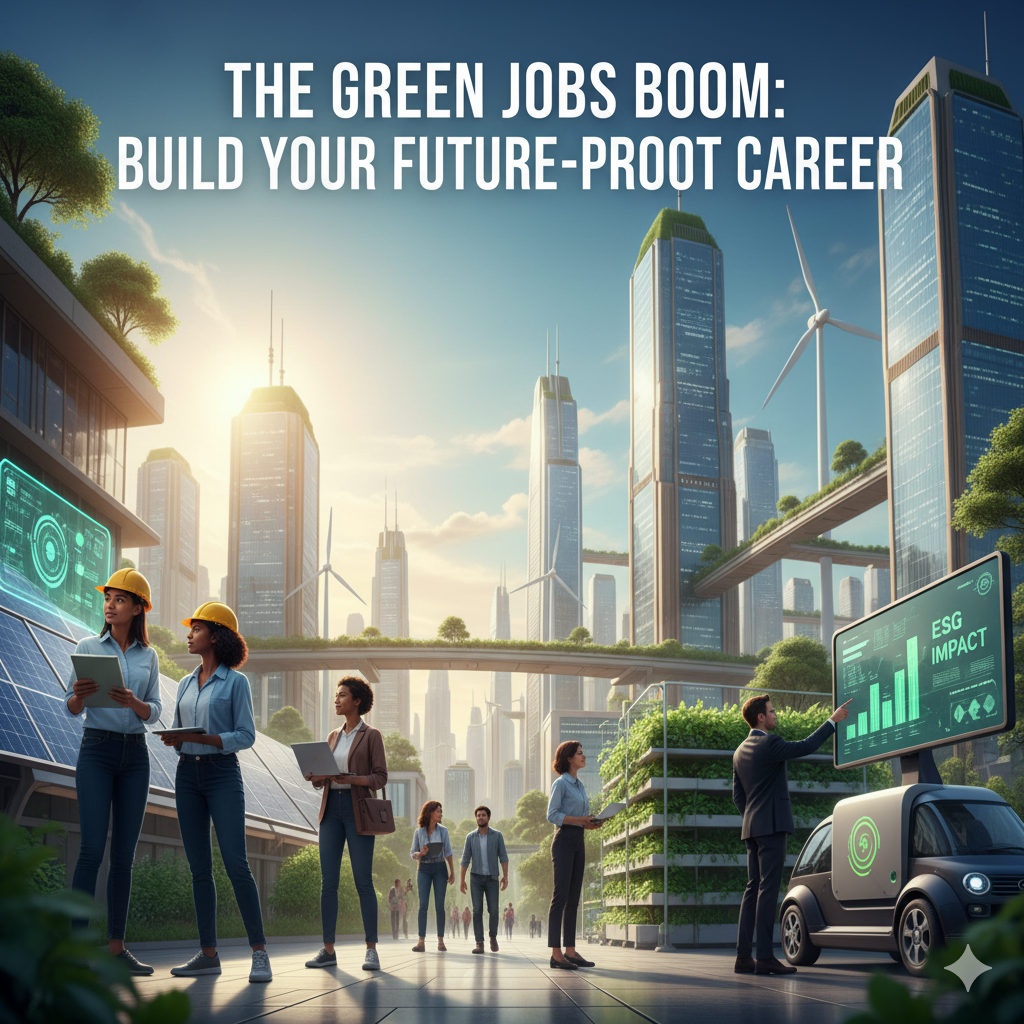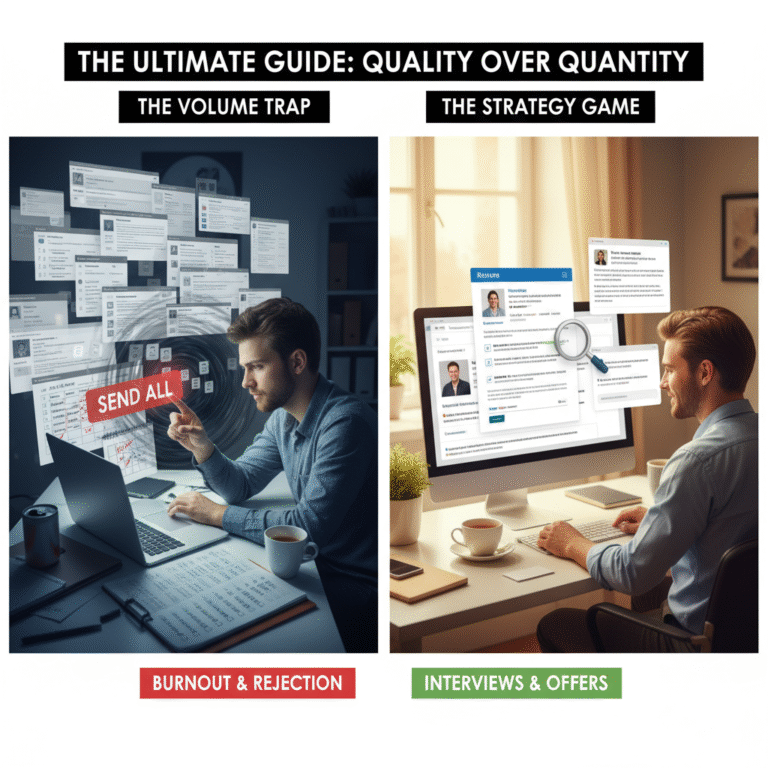The Boom in “Green Jobs”: How to Enter the High-Growth Sustainable Labor Market
There is a quiet revolution happening in the global job market. It’s not happening in social media or the metaverse; it’s happening in our power grids, our supply chains, our construction sites, and our corporate boardrooms. It’s the massive economic shift towards sustainability, and it has triggered a boom in what are now called “Green Jobs.”
This isn’t a niche, feel-good trend. It is a fundamental transformation of the economy, driven by trillions of dollars in new investment, government policy, and consumer demand. For you, the job seeker, this represents one of the single greatest career opportunities of the decade. The demand for “green skills” is exploding, and the supply of qualified talent is critically low. This imbalance creates a golden opportunity for those who are smart enough to get in now.
But what is a “green job”? Is it just about installing solar panels or being an environmental activist? This guide will break down the reality of the sustainable labor market. We’ll define what these roles are, explore the most in-demand sectors, and lay out a practical, step-by-step plan for how you can pivot and build a high-growth career in this booming field, even if you’re starting from scratch.
What Is a “Green Job”? (It’s Not What You Think)
When most people hear “Green Jobs,” they picture someone in a hard hat on a wind turbine. That’s part of it, but it’s a tiny fraction of the reality. The term is much broader and can be broken into two main categories:
- “Core” Green Jobs: These are roles where the primary function is directly tied to sustainability. Think renewable energy engineers, urban farming specialists, conservation scientists, or electric vehicle (EV) charging station technicians.
- “Green-Skilled” Jobs: This is the larger, faster-growing, and more accessible category. These are traditional jobs that have been *transformed* by sustainability requirements. This is where the biggest opportunity lies for most people.
Examples of “Green-Skilled” Jobs include:
- An Accountant who specializes in Carbon Auditing and ESG (Environmental, Social, Governance) reporting.
- A Marketing Manager who builds campaigns around a product’s sustainable sourcing and low carbon footprint.
- A Supply Chain Manager who is now responsible for tracking and reducing emissions across the entire logistics network.
- A Software Developer building an app that helps consumers track their personal energy use.
- A Human Resources specialist who develops corporate sustainability policies and “green” employee benefit programs.
Essentially, almost every career path now has a “green” version. The market needs people who can bridge the gap between traditional business skills and new sustainability goals. That bridge is where you can build your career.
The 4 Hottest Sectors in the Green Economy
While the opportunities are broad, the immediate, high-paying demand is concentrated. If you are looking for an entry point, focus on these four sectors.
1. Renewable Energy & CleanTech
This is the most obvious sector, and for good reason. It’s the engine of the transition. The focus is on moving away from fossil fuels and building the new energy infrastructure.
- In-Demand Roles: Solar Photovoltaic (PV) Installers, Wind Turbine Technicians, Geothermal Engineers, Energy Storage Specialists.
- “Green-Skilled” Roles: Project Managers (for new energy builds), Data Analysts (for grid optimization), Sales Executives (selling B2B energy solutions), Policy Analysts.
2. Sustainable Construction & Green Buildings
Every new building and major renovation is now under pressure to be “greener.” This involves everything from energy-efficient materials and smart (IoT) climate controls to sustainable architecture.
- In-Demand Roles: LEED (Leadership in Energy and Environmental Design) Consultants, Building Information Modeling (BIM) Specialists, Green Architects, HVAC technicians specializing in high-efficiency systems.
- “Green-Skilled” Roles: Construction Managers with sustainability certs, Procurement Specialists (sourcing sustainable materials), Real Estate Appraisers (who can value green features).
3. The “Circular Economy” & Waste Reduction
This is a complete rethinking of “trash.” The circular economy is a model where waste is eliminated, and materials are reused indefinitely. This is a massive logistics and design challenge.
- In-Demand Roles: Recycling Program Managers, Materials Scientists (creating new compostable materials), Waste-to-Energy Plant Operators.
- “Green-Skilled” Roles: Product Designers (designing for disassembly), Supply Chain Analysts (managing reverse logistics), Business Development Managers (finding markets for recycled goods).
4. ESG & Corporate Sustainability
This is the “white-collar” side of the green boom. ESG (Environmental, Social, Governance) is a framework that investors and consumers use to measure a company’s ethical and sustainable impact. Every public company is now building an ESG team.
- In-Demand Roles: ESG Analyst, Sustainability Director, Climate Risk Analyst, Corporate Social Responsibility (CSR) Manager.
- “Green-Skilled” Roles: Lawyers (environmental compliance), Finance Analysts (ESG investing), Communications & PR (writing the annual sustainability report).
Your 5-Step Action Plan to Enter the Green Job Market
You’re convinced. You see the opportunity. How do you make the pivot? Here is a practical, step-by-step plan.
Step 1: Identify Your “Transferable Skill Bridge”
The fastest way in is not to start over, but to *add* a green skill to your *existing* skills. This is your “skill bridge.”
- If you are in Marketing: Your bridge is “Green Marketing” and “Sustainability Communications.”
- If you are in Finance: Your bridge is “ESG Investing,” “Carbon Accounting,” and “Climate-Related Financial Risk.”
- If you are in IT/Tech: Your bridge is “Green Tech,” “Energy Data Analytics,” or “IoT for efficiency.”
- If you are in Project Management: Your bridge is “Renewable Energy Project Management.”
Don’t throw away your experience. Re-frame it. You are not a “beginner.” You are an “Accountant specializing in the new green economy.”
Step 2: Get a Targeted, High-Value Certification
Because this field is so new, certifications are incredibly powerful. They act as a “signal” to employers that you are serious and have the foundational knowledge. You don’t need a four-year degree. A targeted certification is often enough to get your first role.
Top-Tier Certifications to Consider:
- For Business/Finance Professionals: The FSA Credential (Fundamentals of Sustainability Accounting) from SASB is the gold standard for understanding ESG reporting.
- For Building Professionals: Becoming a LEED Green Associate or LEED AP is the global standard for green building.
- For Generalists/Managers: Many universities now offer online “Sustainability Management” or “Circular Economy” certificate courses.
- For Technical Roles: Look for specific certs like the NABCEP PV Installation Professional (for solar).
This certification is your new keyword. You will add it to your resume and your LinkedIn headline.
Step 3: Re-Brand Your Professional Presence (LinkedIn)
Your LinkedIn profile is now your primary marketing tool. You must “green-ify” it.
- Your Headline: Change it from “Marketing Manager” to “Marketing Manager with a focus on Sustainable Brands and Green Communications.”
- Your “About” Summary: Rewrite it to state your new career mission. “As a project manager with 8 years of experience, I am now pivoting to focus my skills on helping renewable energy companies deliver their projects on time and on budget.”
- Your Activity: Start following, sharing, and commenting on content from green industry leaders. Follow hashtags like #sustainability, #esg, and #renewableenergy. This makes you look engaged and passionate.
Step 4: Find the “Hidden” Green Job Boards
These jobs are often not on the giant, generic platforms. You need to go where the industry leaders are posting.
Specialized Job Boards to Bookmark:
- GreenBiz Jobs: One of the most respected platforms, focusing on corporate sustainability, ESG, and CleanTech.
- Eco.org (Environmental Career Opportunities): Excellent for roles in conservation, policy, and advocacy.
- Stockholm Environment Institute (SEI): A global leader in policy and research, their job board is a goldmine for high-level roles.
- BWork: A job board specifically for “B Corps”—companies that are legally certified for their high social and environmental standards.
Also, use targeted keywords on LinkedIn, such as “ESG,” “Sustainability,” “Renewable,” “Circular,” and “Climate.”
Step 5: Master the “Green Interview”
When you get an interview, they will test you on one thing: authenticity. They want to know if you are genuinely passionate about sustainability or just chasing a trend. Be prepared to answer two questions:
- “Why the pivot? Why do you want to work in sustainability?” You must have a personal, authentic story. (e.g., “I’ve been a supply chain manager for years, but I became increasingly concerned about the waste I was seeing. I’m pivoting because I want to use my logistics skills to solve that problem, not just manage it.”)
- “What trends are you following in the green space?” You must be informed. Mention a recent development, like a new piece of legislation, a new technology, or a major company’s new commitment. This proves you are truly engaged in the field.
Conclusion: Your Future-Proof Career
The transition to a sustainable economy is not a “maybe.” It is the single largest economic and industrial shift of our lifetime. Every company, in every industry, will be forced to adapt. This is not just an environmental movement; it is an employment and industrial one.
This creates a rare “ground floor” opportunity. The market for Green Jobs is expanding far faster than the talent pool can keep up. By taking your existing skills, adding a layer of specialized “green” knowledge, and strategically positioning yourself on the right platforms, you are not just finding another job. You are building a future-proof career that offers both high growth and genuine purpose.






